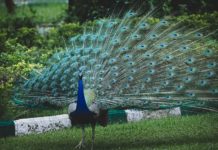Hinduism accepts and advocates evolution. I look upon Dharma as the ethos that promotes social evolution. I depend upon the Taittiriya Upanishad, the concept of the Dahshavatara or ten incarnations of God, and the Gita, to explain evolution according to the Hindu beliefs. We shall discuss these below.
Hindu evolution is different from Darwinian evolution. Darwinian version has two derivative postulates, natural selection and survival of the fittest. According to the first postulate, environment or circumstance decides which species survive under a given set of conditions. Thus, white, snow-covered ground favored the survival of white minnows. They became less visible to predators. When the snow turned blackish with coal ash after industrial revolution, the environment favored the gray-colored bird. Intra- and inter- species competition is implied in the second postulate, namely, survival of the fittest. Hinduism rejects this postulate.
Friedrich Nietzsche extended the second Darwinian postulate to expect super man as the end product of human evolution. He demanded that, to aid evolution of a superman and super human species, societies should mercilessly weed out the morons, the imbecile and the inefficient. He identified Christianity with compassion that offers protection to these ‘anti-evolutionary’ elements. Their propagation should be ruthlessly stopped for evolution to run its course. As a first step Nietzsche said an Anti-Christ would emerge who would purge the society of compassion and eliminate all these genetically regressive individuals. The Nietzsche mind-set inspired the Nazis. Both were mentally deranged. Nietzsche died in a lunatic asylum. Hitler’s sanity was suspect.
I have dealt with Hindu Genesis or the Hindu view of the origin of life in another article. Life on earth has an umbilical connection with the Space-Time or the Universe as shown in the Padmanabha icon. The icon agrees in many details with the conclusions of science.
Taittiriya Upanishad deals with primary evolution. The soul is said to be shrouded by five sheaths respectively. The first sheath is called the anna maya or one made of food, the next one pranamaya or made of breath, then the mano maya or made of mind, followed by vignyana maya or discriminative intelligence and finally a sheath of eternal happiness, Ananda or Bliss.
I interpret these sheaths as the evolutionary stages that life system had passed through in its evolution. The first was the anaerobic life form that depended upon only food for survival and multiplication. These were the most primitive forms. Methanogenic (methane producing) or archae bacteria are in this class.
The next evolutionary development was the appearance of aerobic forms of life that require oxygen for survival. The Upanishad calls this stage the praana maya sheath. The next stage is the appearance of the intelligent forms of life. These are the insect and lower forms of animals. They have the ability to perceive and to react instinctively to their environment. They lack the ability to analyze, sort out and make overall sense out of the messages.
Above the intelligent form is the one called Vignyana or discriminative ability. Collation of a lot of information and analyzing them is the special skill that this form of life has. This is the highest form in evolution. So far only humans have this ability.
The last evolutionary state of bliss is as yet unknown. Gita calls Krishna the Purushottama or the perfect human being. I think he may qualify for the highest evolutionary level.
The dashavatara (or the ten incarnations of god) concept is in agreement with the idea of evolution of species held by biologists. According to the latter life started as unicellular organism in aquatic environment and progressed to the higher forms.
The Avatar idea is a singularly Hindu concept that says that God descends to earth to enforce Dharma or evolution. The Gita asserts, “When Dharma is in trouble and the anti-dharma forces are ascendant, I (Krishna) get born on earth to establish Dharma.” (IV, 7,8) According to fossil records, life had been apparently destroyed several times and reappeared again and again. The destruction of dinosaurs is the most prominent example.
According to biologists life started in water and evolved through several intermediate stages to the Homo Sapiens level.
The ten incarnations of God are justified on the basis of the above assertion. The first avatar is that of fish or Matsya-avataar in aquatic environment. God comes in the form of a fish to save life forms from a flood. The episode of flood finds place in the Mesopotamian epic Gilgamesh. From there it was taken over by the Jews and is now a belief subscribed to by all religions.
The Hindu chronology is set by the date of disappearance of the river Saraswati. The event occurred nine thousand years ago. The riverbed is seen from satellite photography. The river was very broad, 27 kms. at its widest point. The river flowed from Manasarovar lake to the Arabian Sea and disappeared after a cataclysmic upheaval in the Himalayas that blocked its course. Therefore one may be justified to say that Hindu civilization and beliefs are older than the Egyptian and Mesopotamian ones. The distinguishing feature was that Hindu civilization was characterized by cultural artifacts and not by monuments.
The absence of archaeological evidence is because the mythological age was over before the invention of burnt pottery. The method of making fire was invented by a Vedic sage Angiras. The method is still used in the ritual known as Yagnya. It is therefore very plausible that human settlements from the hunter stage started first in Aryaavarta or northern India. Fire God or Agni is considered as the foremost protector (Purohita or foremost well wisher) of humanity (from wild animals). Aryans, Hindus and Zorastrians, are the only people to worship fire as a God.
The next evolutionary stage is amphibian Koorma or the tortoise. This avatar has more than usual significance. The purpose of this avatar was to secure the nectar of immortality from the heavens. Significantly, the turtle has the highest longevity amongst the species.
Strangely, Mongols also regard the Turtle as divine. There was a huge statue of the turtle in the unfinished capital of Ghengis Khan, Karakoram.
The turtle played a major part in the churning of the vast ocean of milk in the outer space. The purpose was to get to nectar. Many animal species and blessed forms of divinity emerge from the ocean. This is important because it confirms what the Padmanabha icon implies, namely, a divine hand/participation in evolution of life. This would correspond to what creationists, mostly based in the US, believe in. They call their belief “intelligent design.”
I am told that a sculptured model of the churning of the ocean of milk is placed in the lobby of the Bangkok airport in Thailand.
The next avatar is Varaha or wild boar. In this stage life has emerged from the aquatic environment and is wholly independent. Varaha is followed by the lower human forms known as Homo erectus in science and in mythology as Narasimha or the man-lion. This species stood erect but was still governed by animal instincts. We hear of monkeys assisting Shri Rama in the epic Ramayana. I would consider these monkeys as subhuman species living side by side with humans without interbreeding.
There is evidence that in an Israeli cave the Neanderthals and the humans lived without interbreeding for 50,000 years.
The midget human Vamana is the next stage in mythological evolution. From there evolution takes us to a rule-bound human in the form of Rama. The last stage of evolution is Krishna, the Purushottama or the perfect human being. This is why Krishna is worshipped in all stages of life- as infant Mukunda, as a child Damodara or Balakrishna, as a carefree teenager, Venu Gopala, as a lover Radhakrishna, as a warrior (Kamsa chaanoora mardana), and finally as the philosopher on the battle field of Kurukshetra. He represents the quintessential joy of life.
The Gita devotes one chapter (X) to evolution in all species. It concludes that all forms of excellence are divine manifestations. This chapter distinguishes Hindu evolution from the Darwinian. Every species evolves independently to the best within its limitations. There is no competition among the species for survival. With this chapter Hinduism rejects the idea that only the fittest survive. Peter principle is more relevant than Darwin.
Peter Principle states that in any organization every employee tends to reach his level of incompetence. When an employee is found efficient at any particular level he is promoted to the next higher level. The process goes on till he is promoted to a point where the employee becomes a misfit and stagnates. Species also tend to follow the rule. They stagnate at the level of their incompetence. Within each species the evolutionary trend is to produce the best. This is what the Gita says.
A corollary is that every one should try to reach the best of his potential. Excellence in any form, profession or activity is divine. If one wants to reach God the only way is to realize one’s highest potential.
Arjuna poses a FAQ: “How does one recognize a divine manifestation”. (17)
Krishna answers:
“There is no limit to my manifestations. I shall tell you the major ones.”
“I abide in all beings. I am the beginning, middle part and end of all creation. (18, 19)
“I am Vishnu among the Adityas. Among the bright objects I am Ravi the Sun God. I am the moon among the stars.” (20)
“Among the Vedas I am Saama Veda. Among the Devas I am Indra. I am the mind among the senses, and consciousness of the created beings.”
“I am Shankara among the Rudras, Kubera of the Rakshasas, and Meru among the mountains. (22)
“I am Brihaspati among the priests, Skanda among the generals and the ocean among water bodies.” (23)
“Among the rishis I am Brgu. In forms of meditation I am Japa. Among the mountains I am the Himalayas. (24)
I am Ashwatta (peepul) among the trees; Narada among the devarishis; Chitraratha among the Gandharvas; and the Muni Kapila among the siddhas. (26)
“I am Ucchaishravas among the horses; know me to be born of the eternity;
I am Airavata among the elephants; among men I ma the king. (27)
“In the weapons class I am Vajra; among the kine I am Kamadhenu;
I am Manmata among the progenitors; Vasuki among the poisonous snakes. (28)
“Among the nonpoisonous snakes I am Ananta (who bears Vishnu in his coils in the Padmanabha icon). Varuna among the Yadasas;
I am Aryama among the forefathers; and Yama among the controllers. (29)
I am Prahlada among the Daityas; among the animals I am the lion; and Garuda among the birds. (30)
I am the Wind God among the purifiers; Rama among the soldiers;
Among the fishes I am the shark; among the rivers I am the Ganga. (31)
Among the Vrishnis I am Vaasudeva and among the Pandavas I am Arjuna;
Among the Munis I am Vyaasa; among the poets Usana. (37)
Finally Krishna sumps up the divine manifestations. “ Wherever one finds brilliance, prosperity and durability recognize the same as a divine manifestation”. (40)
“I pervade the whole Universe and sustain it as my singular manifestation. (42)
The important point is that under divine guidance every species evolves to its most brilliant form. In this respect Hindu evolution differs from Darwinian evolution. At every level there is divine blessing and sustenance for evolution to the best.
Source: http://www.hinduyuva.org/tattva-blog/2008/06/hindu-evolution/




